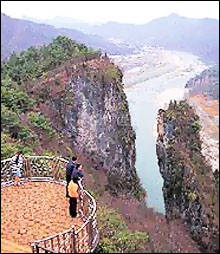| PDF Service | Korean | Japanese | Chinese |
|
|||||||
|
The Mountain Valleys in Yeongwol, Gangwon Province 
Describing the landscape surrounded by the sharp mountain peaks of Seondal and Baekdeok that are more than 1,000 meters above sea level, Korean poets in the past wrote; "a place intermingled with knife mountains and silk soft, clean, and calm streams The Dong River, which originates from a stream at Geumdae-bong, Taebaek, passes Jeongseon and forms a picturesque spot called the Oerayeon at Yeongwol. Until the 1930s, boats carried salt from Mapo Naru (ferry crossing) up the South Han (Namhan) River ending their journey at Yeongwol. Mountaineers at Yeongwol and Jeongseon made rafts from top quality lumber they cut down and rode them down the river to Seoul at Gwang Naru in the east or Mapo Naru in the west. In August there is a raft festival and this is a reenactment of the salt and timber trading that was conducted on the Dong River. Yeongwol was where King Danjong (1447-1457) was sent into exile and although all sides, apart from the west, has remarkable scenery surrounded by the river, it would have been a very lonely place for the banished king. Danjong was a mere puppet king due to his young age. He reigned from 1452 to 1455 but in 1453 his guardians, Hwangbo In and Kim Jong-seo were killed by Suyang Daegun, Danjong's uncle. Suyang Daegun took control over the crown and in 1455 he banished his nephew to Yeongwol. The first place Danjong stayed at in the area is Cheongryeongpo in Gwangcheon-ri of Nam-myeon, Yeongwol. It is now designated as Gangwon Province's memorial spot number five. There are a stone pagoda and memorial within the forests at Cheongryeongpo that are reminders of Danjong's sad fate. An attractive pine tree called the Gwaneum-song stands proudly 30 meters in height with the trunk's circumference at 5 meters. The tree is designated as natural treasure number 349. Its name derives from a legend that Danjong used to sit on the branch of the pine tree and therefore the tree saw ("gwan"--Chinese character "to see") and heard ("eum" --Chinese character for "sound") Danjong's sorrowful moments and laments. There is also a cave called the Go-ssi Donggul (natural treasure number 219). Its name comes from a story that a family with the surname Go hid inside the 6.3 kilometer long cave during the Japanese Invasion in 1597. Restaurants Jangneung Boribab House (033-374-3986) in front of Jangneung (King Danjong's Tomb) is famous for offering barley rice (boribab) and home grown organic vegetables. By Cheongryeongpo, there is Cheongryeongpo Garden (033-373-5600) and some other restaurants which offer hot fish stews. Accommodation There is the Garden-jang (033-373-5794) and Nakwon-jang (033-373-9191) at Yeongwol-eub. How to Get There From Seoul, pass the Yeongdong and Jungang expressways, one comes across Seo Jecheon Interchange. Take the 38 highway and pass through Jecheon, Songhak and Nam-myeon to cross the Yeondang Bridge over the Seo River (Seogang) to reach Jangneung and 2 kilometers away on the right is Cheongyeongpo. Other attractions are within driving distance away and one day is enough to visit them. (Travel Columnist Min Byeong-jun, mbjbud@chollian.net) |
|
||||||||||||||||||||||||||||||||||||||||||||||||||||||
|